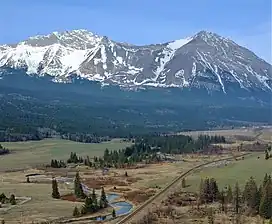Sentry Mountain
Sentry Mountain is a 2,435-metre (7,989-foot) summit located in the Canadian Rockies of Alberta, Canada.
| Sentry Mountain | |
|---|---|
 Sentry Mountain, east-northeast aspect | |
| Highest point | |
| Elevation | 2,435 m (7,989 ft)[1] [2] |
| Prominence | 205 m (673 ft)[3] |
| Listing | Mountains of Alberta |
| Coordinates | 49°36′41″N 114°38′18″W[4] |
| Geography | |
 Sentry Mountain Location of Sentry Mountain in Alberta  Sentry Mountain Sentry Mountain (Canada) | |
| Location | Castle Wildland Provincial Park Alberta, Canada |
| Parent range | Flathead Range[5] Canadian Rockies |
| Topo map | NTS 82G10 Crowsnest[4] |
| Geology | |
| Mountain type | Fault block |
| Type of rock | Limestone |
| Climbing | |
| Easiest route | Scrambling West ridge[6] |
Description
Sentry Mountain is situated 10 kilometers west-southwest of the town of Coleman in the Crowsnest Pass area and can be seen from Highway 3, the Crowsnest Highway, which traverses the northern base of the mountain.[2] It is the northernmost peak of the Flathead Range and is set on land managed by Castle Wildland Provincial Park.[7] Precipitation runoff from the mountain drains into headwaters of the Crowsnest River. Topographic relief is significant as the summit rises 1,080 meters (3,543 feet) above Crowsnest Lake in 1.5 kilometer (0.9 mile). Neighbors include Chinook Peak, 4.0 km (2.5 mi) to the southeast, and Mount Tecumseh is 6.0 km (3.7 mi) to the north. The mountain lies 4.0 km (2.5 mi) east of the Continental Divide.
History
Sentry Mountain was originally named "Sentinel Mountain", but was changed in 1915 to avoid confusion with another by the same name.[1][8] The mountain's toponym was officially adopted in 1924 by the Geographical Names Board of Canada.[4]
Geology
Sentry Mountain is composed of sedimentary rock laid down during the Precambrian to Jurassic periods. Formed in shallow seas, this sedimentary rock was pushed east and over the top of younger Cretaceous period rock during the Laramide orogeny.[9]
Climate
Based on the Köppen climate classification, Sentry Mountain has an alpine subarctic climate with cold, snowy winters, and mild summers.[10] Temperatures can drop below −20 °C with wind chill factors below −30 °C.
Gallery
See also
Further reading
- Scrambles in the Canadian Rockies by Alan Kane
References
- Aphrodite Karamitsanis (1991), Place Names of Alberta, Vol I: Mountains, mountain parks, and foothills, University of Calgary Press, ISBN 978-0919813731, p. 221
- "Sentry Mountain". cdnrockiesdatabases.ca. Retrieved 2022-09-20.
- Sentry Mountain, Peakvisor.com
- "Sentry Mountain". Geographical Names Data Base. Natural Resources Canada. Retrieved 2022-09-20.
- "Flathead Range". Geographical Names Data Base. Natural Resources Canada. Retrieved 2022-09-20.
- Alan Kane (1999), Scrambles in the Canadian Rockies, Rocky Mountain Books, ISBN 9780921102670, p. 54
- Dave Birrell (2000), "50 Roadside Panoramas in the Canadian Rockies", Rocky Mountain Books, ISBN 9780921102656, p. 139
- The Canada Gazette Volume 49, Issues 1-13, (1915) p. 89.
- Gadd, Ben (2008), Geology of the Rocky Mountains and Columbias
- Peel, M. C.; Finlayson, B. L.; McMahon, T. A. (2007). "Updated world map of the Köppen−Geiger climate classification". Hydrol. Earth Syst. Sci. 11: 1633–1644. ISSN 1027-5606.
External links
- Sentry Mountain weather forecast
- Climbing Ostracized Peak & Sentry Mountain (photos): explor8ion.com



